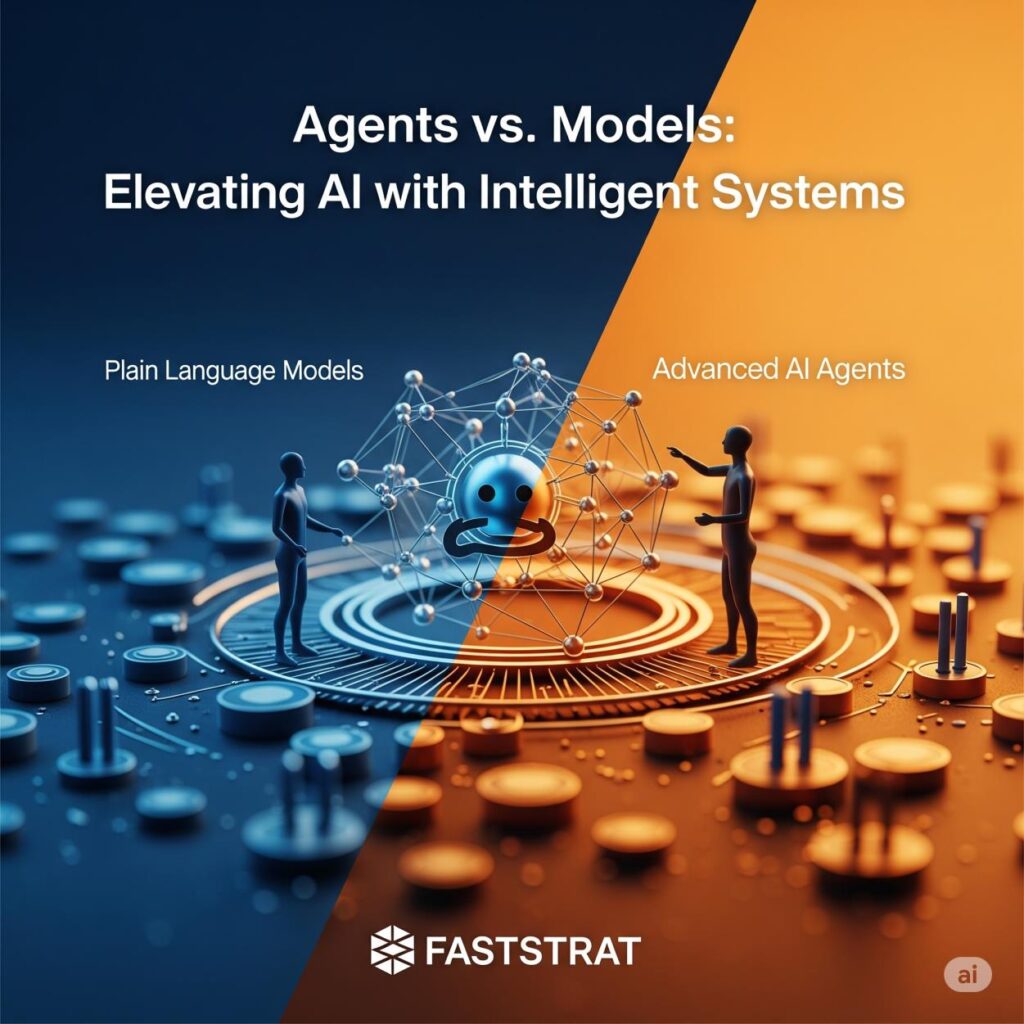Understanding the difference between a plain language model (LM) and an advanced AI agent is key to leveraging technology for transformative business strategies. At FastStrat, we believe that this distinction can unlock new levels of efficiency and innovation. Let’s dive deep into the differences, using a simple yet powerful analogy.
The core differences
| Feature | Language Model | Agent |
| Interaction | One-off predictions | Multi-step, iterative |
| Memory | Stateless | Session-aware |
| Tool usage | Not built-in | Natively supports tool calling |
| Resasoning | Static | Dynamic and planning-based |
| Environment | Isolated | Connected to external systems |
Breaking it down
Interaction:
A language model processes a single input and produces an output. In contrast, an agent engages in a continuous conversation—evaluating context and iterating on its responses to address complex tasks.
Memory:
Language models don’t retain prior conversation history, making them stateless. Agents, however, are session-aware, meaning they keep track of interactions and build upon previous knowledge to deliver coherent, context-rich responses.
Tool Usage:
While language models require manual intervention to access external information, agents are equipped to call on integrated tools (APIs, databases, plugins) automatically. This built-in functionality allows them to interact with the real world directly.
Reasoning:
Language models provide static responses based solely on their training data. Agents utilize dynamic reasoning—employing strategies such as planning and iterative feedback—to make decisions, even adjusting their actions on the fly.
Environment:
Language models operate in isolation, which limits their practical applications. Agents, by contrast, are connected to external systems, enabling them to fetch real-time data and perform actions that drive tangible business outcomes.
The chef metaphor:
Imagine a chef in two scenarios:
Language Model as a Chef:
Think of a chef who only reads a cookbook. This chef can understand recipes and theoretically know how to cook, but they can’t access a kitchen to gather ingredients or experiment with flavors.
Agent as a Chef:
Now, envision that same chef in a fully equipped kitchen. Here, the chef:
Gathers ingredients: Just as an agent retrieves data and accesses APIs.
Cooks the meal: The agent processes the information and produces actionable results.
Adapts to feedback: Adjusts the recipe based on taste tests, akin to how an agent refines its responses with real-time feedback.
Adjusts recipes as needed: Just as an agent adapts its strategy to meet the evolving requirements of a task.
This analogy encapsulates why agents represent a significant leap forward—they don’t just have the theoretical knowledge but can execute, iterate, and deliver real-world value.
Why it matters for FastStrat
At FastStrat, we use the power of AI agents to build systems that are far more than simple query-response tools. By leveraging agents’ multi-step reasoning, memory capabilities, and built-in tool integrations, we can design solutions that:
Automate Complex Workflows: Enable seamless, end-to-end process automation.
Enhance Decision Making: Provide deeper insights through context-aware, dynamic reasoning.
Drive Operational Efficiency: Connect disparate systems and data sources for a holistic approach to problem-solving.
These capabilities empower businesses to move beyond basic automation, achieving smarter and more strategic outcomes.
Embrace the future of intelligent automation with FastStrat, where advanced AI agents turn static data into dynamic, actionable insights—just like a master chef creating a perfect meal every time.

